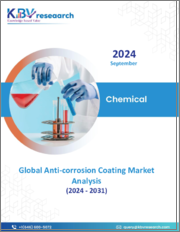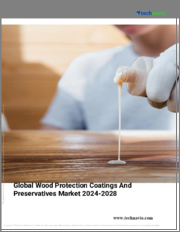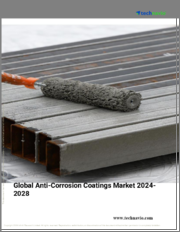
|
시장보고서
상품코드
1609795
일본의 방청 코팅 시장 보고서 : 기술, 재료, 용도, 지역별(2025-2033년)Japan Anti-Corrosion Coatings Market Report by Technology, Material, Application, and Region 2025-2033 |
||||||
일본의 방청 코팅 시장의 시장 규모는 2024년에 21억 3,360만 달러에 달했습니다. 향후 IMARC Group은 2033년에 30억 3,680만 달러에 달하며, 2025-2033년의 성장률(CAGR)은 4%에 달할 것으로 예측하고 있습니다. 자동차나 건설 분야에서의 제품 이용의 증가, 코팅에 대한 나노테크놀러지의 도입, 진행중인 연구개발(R&D) 활동, 다양한 정부 규제나 기준의 시행, 지속가능성에 대한 의식의 향상과 친환경 제품에 대한 요구의 증가 등이 시장을 촉진하는 주요 요인입니다.
본 리포트에서 답변하는 주요 질문
- 일본의 방청 코팅 시장은 지금까지 어떻게 추이해 왔으며, 향후 어떻게 추이하는가?
- COVID-19가 일본의 방청 코팅 시장에 미친 영향은?
- 일본의 방청 코팅 시장의 기술별 내역은?
- 일본의 방청 코팅 시장의 재료별 구성비는?
- 일본의 방청 코팅 시장의 용도별 내역은?
- 일본의 방청 코팅 시장의 밸류체인에는 어떤 단계가 있는가?
- 일본의 방청 코팅에서 주요 촉진요인과 과제는?
- 일본의 방청 코팅 시장의 구조와 주요 기업은?
- 일본의 방청 코팅 시장에서 경쟁 정도는?
목차
제1장 서문
제2장 조사 범위와 조사 방법
- 조사의 목적
- 이해관계자
- 데이터 소스
- 시장 추정
- 조사 방법
제3장 개요
제4장 일본의 방청 코팅 시장 : 서론
- 개요
- 시장 역학
- 업계 동향
- 경쟁 정보
제5장 일본의 방청 코팅 시장 구도
- 과거 및 현재 시장 동향(2019-2024년)
- 시장 예측(2025-2033)
제6장 일본의 방청 코팅 시장 : 기술별 내역
- 용제 베이스
- 수성
- 분말
- 기타
제7장 일본의 방청 코팅 시장 : 재료별 내역
- 아크릴
- 알키드
- 폴리우레탄
- 에폭시
- 아연
- 기타
제8장 일본의 방청 코팅 시장 : 용도별 내역
- 석유 및 가스
- 해양
- 건축·건설
- 자동차와 철도
- 항공우주 및 방위
- 기타
제9장 일본의 방청 코팅 시장 : 경쟁 구도
- 개요
- 시장 구조
- 시장 기업 포지셔닝
- 주요 성공 전략
- 경쟁 대시보드
- 기업 평가 상한
제10장 주요 기업의 개요
제11장 일본의 방청 코팅 시장 : 업계 분석
- 촉진요인·억제요인·기회
- Porter's Five Forces 분석
- 밸류체인 분석
제12장 부록
KSA 24.12.24The Japan anti-corrosion coatings market size reached USD 2,133.6 Million in 2024. Looking forward, IMARC Group expects the market to reach USD 3,036.8 Million by 2033, exhibiting a growth rate (CAGR) of 4% during 2025-2033. The increasing product utilization in the automotive and construction sectors, the incorporation of nanotechnology in coatings, ongoing research and development (R&D) activities, the implementation of various government regulations and standards, and the growing awareness of sustainability and the need for eco-friendly products represent some of the key factors driving the market.
Anti-corrosion coatings refer to specialized coatings applied to surfaces to protect them from corrosion. They are formulated using various materials, such as epoxy, polyurethane, zinc, and acrylic. Anti-corrosion coatings are available in various types, including organic, inorganic, and hybrid coatings. They are characterized by their unique properties, like excellent adhesion, water resistance, and chemical resistance. Anti-corrosion coatings are widely utilized in various applications, such as automotive, marine, oil and gas, construction, power generation, and industrial machinery. They offer a wide range of benefits, including extended equipment life, reduced maintenance costs, and improved aesthetics. In addition to this, anti-corrosion coatings are also known for their versatility, eco-friendliness, cost-effectiveness, and efficiency in extreme conditions.
Japan Anti-Corrosion Coatings Market Trends:
The increasing demand for anti-corrosion coatings in the automotive sector to extend the lifespan of vehicles and their components is creating a positive outlook for the market growth. Moreover, the growing shipping and marine industry in Japan, facilitating widespread product adoption for protecting ships and underwater structures from corrosive seawater, is providing a thrust to the market growth. Along with this, the rising utilization of anti-corrosion coating in the construction industry due to rapid urbanization and modernization is favoring the market growth. In line with this, the increasing product application to protect structural steel, concrete, and other construction materials from degrading over time is anticipated to drive the market growth. In addition to this, the expanding manufacturing industries like the electronics sector, prompting the adoption of coatings to safeguard intricate components from corrosion and enhance their durability, is bolstering the market growth. Additionally, the incorporation of nanotechnology in coatings, leading to the development of more efficient and long-lasting solutions, is providing a considerable boost to the market growth. In confluence with this, the growing coating application in harsh environments, such as high levels of salt or extreme temperatures, is supporting the market growth. Apart from this, the ongoing research and development (R&D) activities, resulting in coatings with self-healing properties, are acting as a growth-inducing factor. Furthermore, the rising focus on clean energy, leading to an increasing need for coatings that protect wind turbines, solar panels, and other related equipment from the elements to ensure efficiency and longevity, is creating a positive outlook for the market growth. Additionally, the implementation of various government regulations and standards advocating for quality and safety across industries, which is compelling businesses to adopt anti-corrosion coatings, is accelerating the market growth. Besides this, the growing awareness of sustainability and the need for eco-friendly products, encouraging manufacturers to produce coatings with low volatile organic compound (VOC) emissions, is positively influencing the market growth across the country.
Japan Anti-Corrosion Coatings Market Segmentation:
Technology Insights:
- Solvent-based
- Water-based
- Powder
- Others
Material Insights:
- Acrylic
- Alkyd
- Polyurethane
- Epoxy
- Zinc
- Others
Application Insights:
- Oil and Gas
- Marine
- Building and Construction
- Automotive and Rail
- Aerospace and Defense
- Others
Competitive Landscape:
The market research report has also provided a comprehensive analysis of the competitive landscape. Competitive analysis such as market structure, key player positioning, top winning strategies, competitive dashboard, and company evaluation quadrant has been covered in the report. Also, detailed profiles of all major companies have been provided.
Key Questions Answered in This Report:
- How has the Japan anti-corrosion coatings market performed so far and how will it perform in the coming years?
- What has been the impact of COVID-19 on the Japan anti-corrosion coatings market?
- What is the breakup of the Japan anti-corrosion coatings market on the basis of technology?
- What is the breakup of the Japan anti-corrosion coatings market on the basis of material?
- What is the breakup of the Japan anti-corrosion coatings market on the basis of application?
- What are the various stages in the value chain of the Japan anti-corrosion coatings market?
- What are the key driving factors and challenges in the Japan anti-corrosion coatings?
- What is the structure of the Japan anti-corrosion coatings market and who are the key players?
- What is the degree of competition in the Japan anti-corrosion coatings market?
Table of Contents
1 Preface
2 Scope and Methodology
- 2.1 Objectives of the Study
- 2.2 Stakeholders
- 2.3 Data Sources
- 2.3.1 Primary Sources
- 2.3.2 Secondary Sources
- 2.4 Market Estimation
- 2.4.1 Bottom-Up Approach
- 2.4.2 Top-Down Approach
- 2.5 Forecasting Methodology
3 Executive Summary
4 Japan Anti-Corrosion Coatings Market - Introduction
- 4.1 Overview
- 4.2 Market Dynamics
- 4.3 Industry Trends
- 4.4 Competitive Intelligence
5 Japan Anti-Corrosion Coatings Market Landscape
- 5.1 Historical and Current Market Trends (2019-2024)
- 5.2 Market Forecast (2025-2033)
6 Japan Anti-Corrosion Coatings Market - Breakup by Technology
- 6.1 Solvent-based
- 6.1.1 Overview
- 6.1.2 Historical and Current Market Trends (2019-2024)
- 6.1.3 Market Forecast (2025-2033)
- 6.2 Water-based
- 6.2.1 Overview
- 6.2.2 Historical and Current Market Trends (2019-2024)
- 6.2.3 Market Forecast (2025-2033)
- 6.3 Powder
- 6.3.1 Overview
- 6.3.2 Historical and Current Market Trends (2019-2024)
- 6.3.3 Market Forecast (2025-2033)
- 6.4 Others
- 6.4.1 Historical and Current Market Trends (2019-2024)
- 6.4.2 Market Forecast (2025-2033)
7 Japan Anti-Corrosion Coatings Market - Breakup by Material
- 7.1 Acrylic
- 7.1.1 Overview
- 7.1.2 Historical and Current Market Trends (2019-2024)
- 7.1.3 Market Forecast (2025-2033)
- 7.2 Alkyd
- 7.2.1 Overview
- 7.2.2 Historical and Current Market Trends (2019-2024)
- 7.2.3 Market Forecast (2025-2033)
- 7.3 Polyurethane
- 7.3.1 Overview
- 7.3.2 Historical and Current Market Trends (2019-2024)
- 7.3.3 Market Forecast (2025-2033)
- 7.4 Epoxy
- 7.4.1 Overview
- 7.4.2 Historical and Current Market Trends (2019-2024)
- 7.4.3 Market Forecast (2025-2033)
- 7.5 Zinc
- 7.5.1 Overview
- 7.5.2 Historical and Current Market Trends (2019-2024)
- 7.5.3 Market Forecast (2025-2033)
- 7.6 Others
- 7.6.1 Historical and Current Market Trends (2019-2024)
- 7.6.2 Market Forecast (2025-2033)
8 Japan Anti-Corrosion Coatings Market - Breakup by Application
- 8.1 Oil and Gas
- 8.1.1 Overview
- 8.1.2 Historical and Current Market Trends (2019-2024)
- 8.1.3 Market Forecast (2025-2033)
- 8.2 Marine
- 8.2.1 Overview
- 8.2.2 Historical and Current Market Trends (2019-2024)
- 8.2.3 Market Forecast (2025-2033)
- 8.3 Building and Construction
- 8.3.1 Overview
- 8.3.2 Historical and Current Market Trends (2019-2024)
- 8.3.3 Market Forecast (2025-2033)
- 8.4 Automotive and Rail
- 8.4.1 Overview
- 8.4.2 Historical and Current Market Trends (2019-2024)
- 8.4.3 Market Forecast (2025-2033)
- 8.5 Aerospace and Defense
- 8.5.1 Overview
- 8.5.2 Historical and Current Market Trends (2019-2024)
- 8.5.3 Market Forecast (2025-2033)
- 8.6 Others
- 8.6.1 Historical and Current Market Trends (2019-2024)
- 8.6.2 Market Forecast (2025-2033)
9 Japan Anti-Corrosion Coatings Market - Competitive Landscape
- 9.1 Overview
- 9.2 Market Structure
- 9.3 Market Player Positioning
- 9.4 Top Winning Strategies
- 9.5 Competitive Dashboard
- 9.6 Company Evaluation Quadrant
10 Profiles of Key Players
- 10.1 Company A
- 10.1.1 Business Overview
- 10.1.2 Product Portfolio
- 10.1.3 Business Strategies
- 10.1.4 SWOT Analysis
- 10.1.5 Major News and Events
- 10.2 Company B
- 10.2.1 Business Overview
- 10.2.2 Product Portfolio
- 10.2.3 Business Strategies
- 10.2.4 SWOT Analysis
- 10.2.5 Major News and Events
- 10.3 Company C
- 10.3.1 Business Overview
- 10.3.2 Product Portfolio
- 10.3.3 Business Strategies
- 10.3.4 SWOT Analysis
- 10.3.5 Major News and Events
- 10.4 Company D
- 10.4.1 Business Overview
- 10.4.2 Product Portfolio
- 10.4.3 Business Strategies
- 10.4.4 SWOT Analysis
- 10.4.5 Major News and Events
- 10.5 Company E
- 10.5.1 Business Overview
- 10.5.2 Product Portfolio
- 10.5.3 Business Strategies
- 10.5.4 SWOT Analysis
- 10.5.5 Major News and Events
11 Japan Anti-Corrosion Coatings Market - Industry Analysis
- 11.1 Drivers, Restraints, and Opportunities
- 11.1.1 Overview
- 11.1.2 Drivers
- 11.1.3 Restraints
- 11.1.4 Opportunities
- 11.2 Porters Five Forces Analysis
- 11.2.1 Overview
- 11.2.2 Bargaining Power of Buyers
- 11.2.3 Bargaining Power of Suppliers
- 11.2.4 Degree of Competition
- 11.2.5 Threat of New Entrants
- 11.2.6 Threat of Substitutes
- 11.3 Value Chain Analysis



















